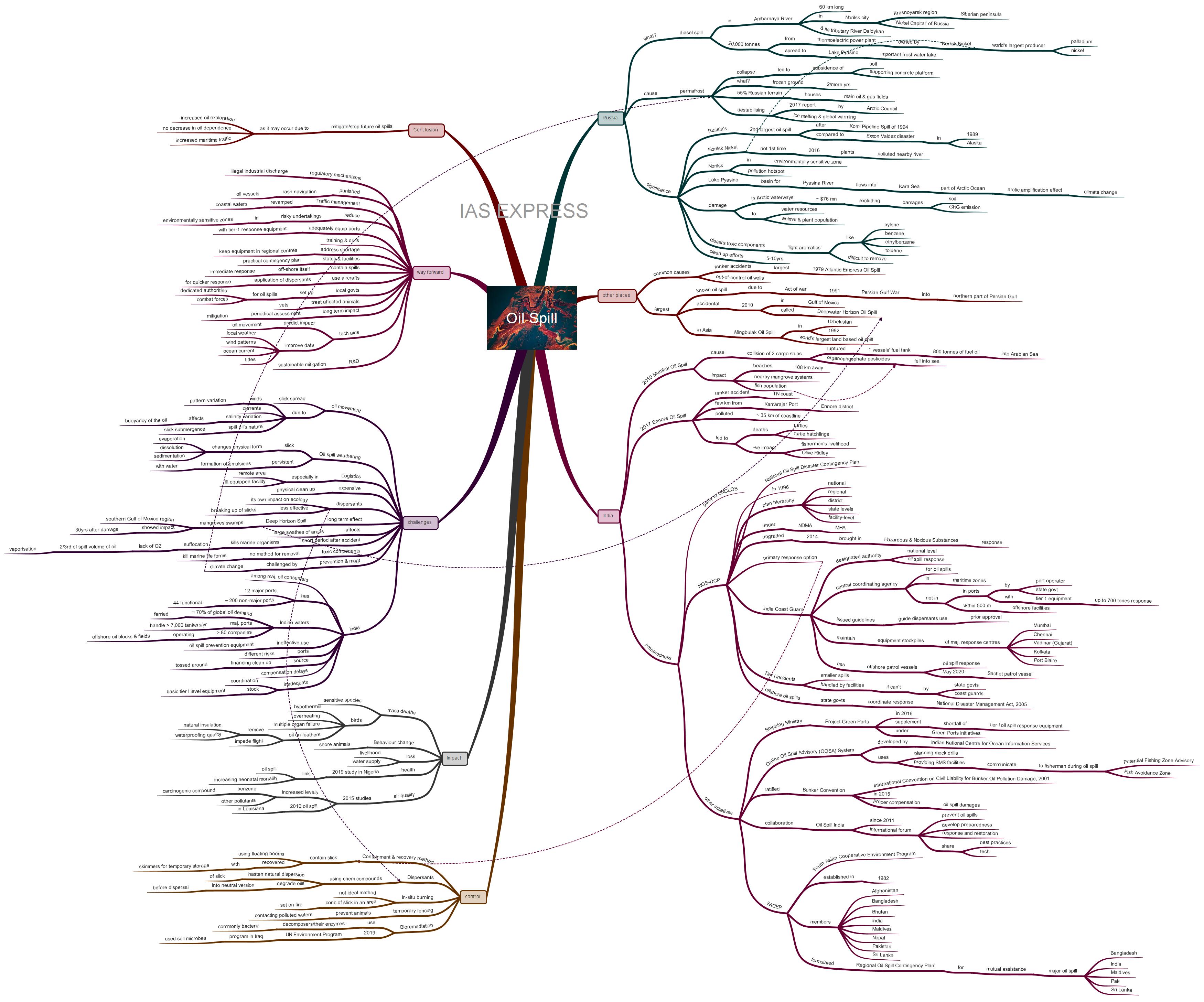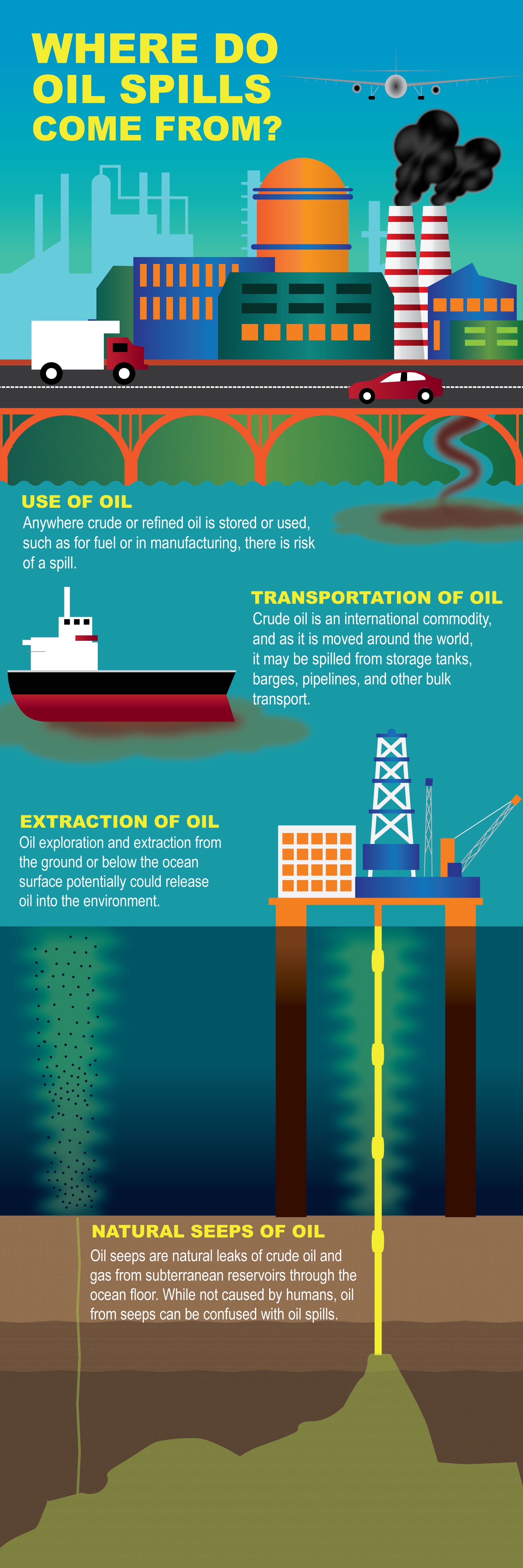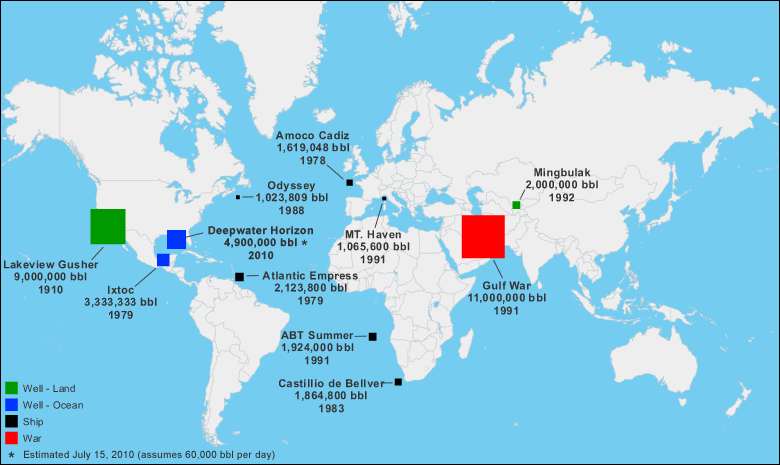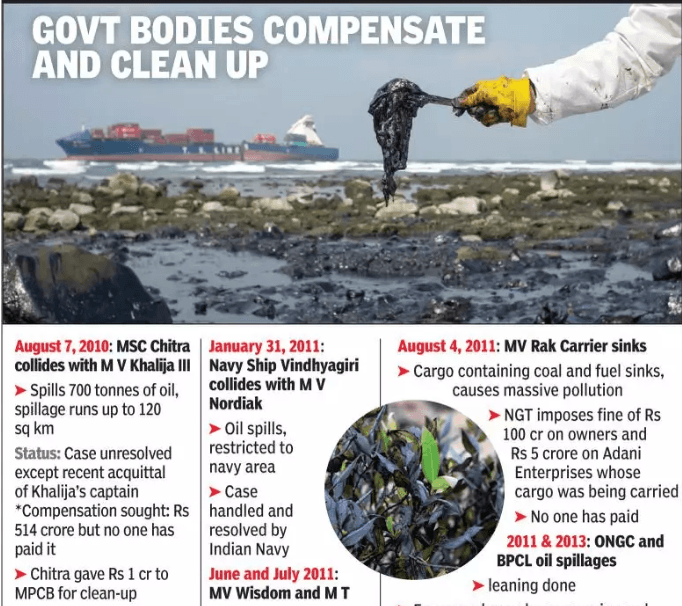[Disaster Series] Oil Spill – Impact, Challenges, Way Ahead
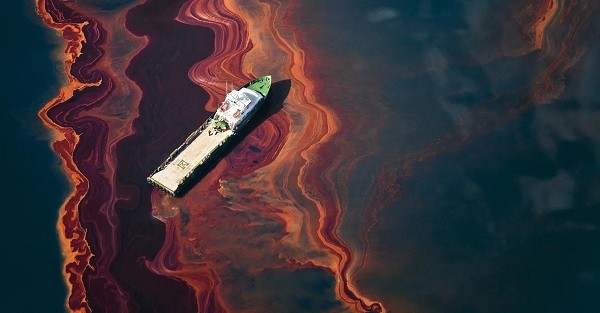
In May, the thousands of tonnes of diesel spilled into the Ambarnaya River, turning its surface crimson. The Russian government had to declare a state of emergency amid criticism from environmentalists. Such a major accident in an environmentally sensitive zone has sparked serious concerns. In this context, India’s preparedness to deal with oil spills needs to be examined.
What is the recent Russian oil spill incident?
- The oil spill occurred in Ambarnaya River– a 60 km long river in Norilsk city of Krasnoyarsk region in the sparsely populated Siberian peninsula in Russia. Norilsk is the ‘Nickel Capital’ of Russia.
- 20,000 tonnes of diesel spilled from a thermoelectric power plant into the river- spreading over a 350 square metre area. The surface of the river turned crimson.
- The offending power plant is owned by Norlisk Nickel– the largest producer of 2 metals, nickel and palladium, in the world
- The oil spill also affected one of Ambarnaya River’s tributaries- River Daldykan.
- In June, the Russian government declared a state of emergency. The state constructed booms (floating barriers) to contain its spread. Norilsk Nickel claimed to have removed at least 500 cubic metre of pollutants.
- However, these failed and the oil spread further into an important freshwater lake further up north- Lake Pyasino.
Why did it happen?
- The spill is said to have been caused by collapsing permafrost. It caused the subsidence of soil and the supporting concrete platform which in turn caused the pillars to collapse- resulting in a loss of containment.
- Permafrost is the ground that remains continuously frozen for 2 or more years. It is composed of soil, sediments and rocks bound together by ice. Some permafrost have remained frozen for as long thousands of years.
- About 55% of Russian terrain- particularly in Siberia– is permafrost. This is also the area that holds many of its main oil and gas fields.
- A 2017 report from Arctic Council had flagged the issue of destabilising permafrost due to melting ice and global warming. It warned that foundations in such regions would no longer be able to support the load as they did in the 1980s.
- Apart from this, the Arctic region has been facing unusually warm weather these few weeks. This is being attributed to global warming.
Why is this incident significant?
- This is only the 2nd largest oil spill in Russia after the Komi Pipeline Spill of 1994. It is being compared to the Exxon Valdez disaster that occurred in 1989 in Alaska.
- For Norilsk Nickel itself, this isn’t the first such accident. In 2016, one of its plants polluted a nearby river and turned it red. Norilsk, despite its location in an environmentally sensitive zone, is a pollution hotspot because of its industrial activity.
- Environmentalists have estimated that the damage caused by the spill to Arctic waterways could be over 76 million USD. This is excluding the damages caused to the soil and the damages in the form of greenhouse gas emissions.
- Lake Pyasino is the basin for the Pyasina River which flows into the Kara Sea in the north- a part of the Arctic Ocean. The Arctic Ocean is already vulnerable to the effects of climate change due to arctic amplification effect and its ecosystem is one of the most sensitive.
- Though the surface oils are being mopped up to a certain extent, it is to be noted that the most toxic components of diesel are the ‘light aromatics’ such as xylene, benzene, toluene and ethylbenzene. These can dissolve in the water and hence, difficult to remove.
- These pollutants are bound to have a negative impact on water resources and on the animal and plant populations that depend on it.
- The clean-up efforts in the Ambarnaya River and its surrounding is expected to take between 5 years to a decade.
Has there been such oil spills elsewhere?
- Across the world, there have been numerous instances of oil spills. These have been caused by various reasons like acts of war, tanker accidents, out of control wells, etc.
- Of these reasons, tanker accidents are the most common cause of oil spills. The largest of such incidents was the 1979 Atlantic Empress Oil Spill.
- Though not as frequent, the out-of-control oil wells are responsible for some of the world’s largest spills.
- However, the largest known oil spill in history was due to an act of war i.e. not accidental. It occurred in 1991 during the Persian Gulf War when the retreating Iraqi forces released millions of gallons of oil (380 to 520 million gallons according to some estimates) into the northern part of Persian Gulf.
- The largest accidental oil spill happened in 2010 in Gulf of Mexico. Dubbed the Deepwater Horizon Oil Spill, the incident was caused by a blowout.
- Another major accidental oil spill was the Ixtoc 1 Oil Spill in Mexico in 1979. This was also due to failure of a blowout preventer.
- Oil spills can happen over land too. Asia’s largest oil spill- the Mingbulak Oil Spill in Uzbekistan in 1992 is also the world’s largest land based oil spill.
Has there been oil spills in India?
India too has had its share of oil spills.
2010 Mumbai Oil Spill
- The Mumbai Oil Spill, incidentally, occurred in the same year as the infamous Deep Horizon Oil Spill.
- It was caused by collision of 2 cargo ships off the coast of Maharashtra. The collision impact ruptured one of the vessels’ fuel tank, releasing 800 tonnes of fuel oil into the Arabian Sea.
- Apart from the oil spill, one of the vessels was bearing toxic organophosphate pesticides, which also fell into the sea.
- Even after this incident, several oil spills have occurred in this area over the years.
Impacts
- Even the initial assessment showed that the oil had spread to affect beaches 108 km away from the accident site.
- The nearby mangrove systems were greatly affected with vast stretches turning black.
- Apart from the oil, the chemicals that were sprayed to disperse the spilt oil also added to the negative impact on the fish population. The catch achieved by fishermen in this region has been declining steadily.
- Corpses of dolphins and other mammals that washed ashore revealed that they were affected by the spills leading to respiratory infections.
2017 Ennore Oil Spill
- A tanker accident off the Tamil Nadu coast had caused a large oil spill in 2017. This occurred just a few kilometres from the Kamarajar Port of Ennore district.
- The spill had polluted nearly 35 km of the coastline.
Impacts
- Post the spill, large number of dead turtles and turtle hatchlings were discovered near the shore.
- Olive Ridley turtles are known to nest in this region.
- The livelihood of fishermen were affected. The people of the area were trouble by the stench emanating from the spill.
How is oil spill controlled?
- Containment & recovery method: floating booms are used to contain the slick to a certain area. This is then recovered with the help of skimmers for temporary storage.
- Dispersants: chemical compounds are used to hasten the natural dispersion of the slick. The compounds can degrade the oils into more neutral versions before dispersal.
- In-situ burning: a less ideal method involves concentration of the slick to a specific area and setting it on fire to hasten its removal from the waters.
- Use of temporary fencing to prevent wild animals from coming into contact with polluted waters.
- Bioremediation: use of decomposers or their enzymes to clean up the oil spills. Bacteria are some of the commonly used bioremediation agents. Eg: In 2019, the UN Environment Program launched a program in Iraq where the authorities made use of soil microbes to devour oil spills to decontaminate the lands.
How prepared is India to handle such spills?
- India is party to UNCLOS (United Nations Convention on the Law of the Sea). It is obligated to protect the marine environment.
- The National Oil Spill Disaster Contingency Plan (NOS-DCP) was promulgated in 1996 for responding to oil spill incidents. Its hierarchy of contingency plans consists of plans at national, regional, district and state levels along with a facility-level The NOS-DCP is under the purview of National Disaster Management Authority under the Home Ministry.
- In has been updated several times over the years. In its 2014 updation, it brought in plans for responding to HNS (Hazardous and Noxious Substances) incidents as well.
- The India Coast Guard is the designated authority at the national level for oil spill response according to the NOS-DCP. It functions as the central coordinating agency for oil spills in maritime zones- except in ports and within 500 m of offshore facilities like refineries.
- Tier I incidents (smaller spills) are to be handled by the facilities themselves in their designated areas. The state government or the Coast Guard would step in if the response is beyond the facility’s capabilities.
- Spill in port areas are to be handled by port operator itself or the relevant state government authority. These facilities are required to possess tier 1 equipment for response up to 700 tones.
- In case of offshore oil spills, the coastal states’ governments are responsible for coordinating response as per the National Disaster Management Act of 2005.
- The primary response option for oil spills at sea is mechanical containment and recovery.
- The Coast Guard-issued guidelines guide the use of dispersants for diffusing the oil. Prior approval is required for their use as the eco-sensitivity of the region is to be taken into consideration.
- The recovered oil is stored in temporary pits till they are taken to reception facilities.
- The Coast Guard maintains equipment stockpiles at major response centres- Mumbai, Chennai, Kolkata, Port Blair and Vadinar (Gujarat).
- Most of the major ports and the non-major ports that are currently functional have oil spill response equipment. They have also trained their staffs to enable quick response during emergencies.
- Some of the oil spill response equipment includes inflatable booms, skimmers, etc.
- Several offshore patrol vessels or OPVs like the ICGS Vaibhav (in 2013) and ICGS Sujay (in 2017) have been inducted into the ICG over the years. These OPVs possess equipment capable of oil spill response.
- Even amid the lockdown, the ICG recently inducted the Sachet patrol vessel– capable of carrying out oil spill response- in May.
Other Initiatives
- The Shipping Ministry in 2016 started the Project Green Ports. Making up for shortfall in tier I oil spill response equipment is one of the objectives of its Green Ports Initiatives.
- India became one of the few countries that have indigenously developed capacities for predicting the trajectory of oil spills, mapping environmental sensitivities in coastal areas, deploying aerial dispersant spray system, etc. with the establishment of the Online Oil Spill Advisory (OOSA) System. The OOSA software was indigenously developed by INCOIS (Indian National Centre for Ocean Information Services).
- It is used for planning mock drills, providing SMS facilities to communicate with fishermen regarding “Potential Fishing Zone Advisory” and “Fish Avoidance Zone” in case of an oil spill.
- India ratified the Bunker Convention (International Convention on Civil Liability for Bunker Oil Pollution Damage, 2001) in 2015. This ensures proper compensation for damages due to oil spills.
- India has been collaborating with Oil Spill India since 2011. It is an international forum that focuses on prevention of oil spills, developing preparedness, response and restoration. It showcases the best practices, technologies and also experiences with respect to oil spill management.
- The South Asian Cooperative Environment Program (SACEP) was established in 1982 with Afghanistan, Bangladesh, Bhutan, India, Maldives, Nepal, Pakistan and Sri Lanka. The SACEP had formulated the ‘Regional Oil Spill Contingency Plan’ to enable cooperation and mutual assistance in case of a major oil spill event in the waters around Bangladesh, India, Maldives, Pakistan and Sri Lanka
What are the impacts of oil spills?
- Mass deaths of sensitive species often accompany oil spills.
- Birds are one of the most visibly affected class of organisms by oil spills. The oil residues coat the feathers, strip them off their natural insulation and waterproofing quality apart from impeding their ability to fly. They often die out due to hypothermia, overheating or multiple organ failure due to ingestion of the pollutants.
- Behaviour change among the shore animals have been observed in the aftermath of oil spills. Eg: crabs have been noted to become slower to respond to threat of predators and unable to construct proper burrows.
- Apart from affecting the local ecosystem, the spill affects the livelihood of the local residents- especially the fishing community.
- The water supplies to the local settlements are affected. In 2013, an oil spill affected the water supply to 3 lakh people in Malaysia and 80,000 people in Ecuador.
- The health of the locals are also impacted- causing a range of issues like increased cancer risk, respiratory illnesses, compromised immune system, etc. A 2019 study in Nigeria revealed a link between oil spills and increasing neonatal mortality.
- The oil spills can affect the air quality in surrounding areas. In 2015, studies showed heightened levels of benzene (a carcinogenic compound) and other pollutants from the 2010 oil spill in the air in Louisiana.
What are the challenges in cleaning up oil spills?
- Oil movement is a major challenge. In just a short time-span, the slick can spread over many square kilometres and even break up into bands that move depending on the winds and currents. This affects the effectiveness of at-sea responses.
- The movement is further affected by various factors like local wind pattern variations, variation in salinity of the waters affecting the buoyancy of the oil, the spilt oil’s nature– like submergence of the slick in rougher seas, etc.
- Weathering of oil spills is a concern. Weathering is the process by which the slick changes its physical form and it occurs by evaporation, dissolution, sedimentation, etc. Its persistence increase by formation of emulsions with water.
- Logistics is a major challenge in cleaning up oil spills. This is especially evident when the accident site is remote and the facility is ill equipped- in terms of response equipment or training.
- Physical clean-up is often expensive. The choice of using of dispersants to clean up spills often involves trade-off with the dispersant’s own impact on ecology. Breaking up of the slick into bands and quick spread affect the success of dispersants.
- Oil spills tend to have a long term effect. In case of the Deep Horizon Spill, the mangroves swamps in the southern Gulf of Mexico region showed damages 30 years after the incident.
- The accidents tend to affect large swathes of areas– especially when spilt into the seas. The oil spill in Alaska affected the coast of France– an entire ocean away.
- About 2/3rd of the spilt volume of oil tends to vaporize away within a short period of the accident. However, within this period, the oil cuts off oxygen supply to the sea and kills the marine organisms off by suffocation.
- Apart from this, the dissolved toxic components from the oil spill affect the marine life forms. There isn’t a way to remove these dispersed compounds.
- In the Norilsk Oil Spill incident, the issue of climate change as a challenge in oil spill prevention and management became evident. Defrosting permafrost is not an issue that can be dealt with locally except bringing in more resilient support structures.
- The incident also highlights the difficulty in mitigating such accidents in the remote Arctic regions. It is noted that many oil spills occur on the high seas. Its containment and mitigation are more difficult than in the case of coastal spills.
For India
- It is to be noted that India is one of the largest oil consumers in the world. Nearly 70% of the world’s oil demand is ferried through the waters in our vicinity.
- The major ports in India handle more than 7,000 tankers every year. In addition to this, more than 80 companies are operating in offshore oil blocks and fields. This is set to expand in the future. Hence the risk of a major oil spill in the Indian waters is only increasing.
- India has a very long coastline-7,500 km There are 12 major ports, over 200 non-major ports out of which 44 are functional. There is a need to ensure that all these ports are properly equipped to ensure expedited response.
- Shipping industries allege that though these equipment are piled at these ports, they are ineffectively used.
- The risk is not homogenous across these ports. Each port deals with different types of cargoes and hence faces different types of risks.
- The onus of paying for the clean-up activity often get tossed around as seen in case of the 2010 spill. Despite clear ruling on who is to pay the damages, the compensations often go unpaid for several years. In the end, the state pollution control board ends up having to burden the costs.
- In case of Ennore oil spill, a major issue noted was the absence of a contingency plan with the Tamil Nadu government. This is despite the NOS-DCP requirement of all coastal states to have one in readiness.
- There was also evident lack of coordination among the authorities apart from inadequate stock of even the basic tier I level equipment.
What is the way forward?
- Not all oil spills are accidental. Some are due to illegal industrial discharge. These can be controlled by well-oiled regulatory mechanisms.
- Rash navigation by captains of oil bearing vessels must be punished to have a deterrent effect. Traffic management in the coastal waters must be revamped especially given the increasing dependence on maritime routes for transport of goods vital to the world economies.
- Setting up of risky undertakings involving large quantities of oil and other HNS in environmentally sensitive zones like the Arctic must be reduced.
- The ports are to be adequately equipped with tier-1 response equipment. Trainings and drills must be used to equip the response capacities of its staffs.
- The government had been mulling the consolidation of equipment a select regional centres to enable a wider access of equipment to non-major ports. This could address shortages.
- The coastal states and the facilities themselves must have practical contingency plan in the ready. This must not be put off any longer. Academicians, environmentalists and disaster management experts can be roped in for a well-rounded response plan.
- Spills must be contained off-shore Expedited response is vital to stop it from reaching the shores and causing widespread damage to the settlements.
- Instead of ships and OPVs, aircrafts can be preferred for application of dispersants. This will enable quicker response and wider coverage by the equipment.
- The local governments of regions housing major ports with high traffic of oil tankers can mull the establishment of dedicated authorities and combat forces specially trained in oil spill response.
- Engagement of adequate veterinary personnel in times of oil spills to treat the affected animals. This will reduce the mass casualties of the wildlife.
- Long term impacts must be periodically assessed to achieve maximum mitigation.
- Technological aids can be utilized in predicting the various factors affecting oil movement. Improving the data available on local weather, wind patterns, ocean currents, tides, etc. would greatly improve the effectiveness of the mitigation efforts.
- Research and development is to be encouraged to develop ways of sustainably mitigating the effects of oil spills.
Conclusion
With the melting Arctic zone, more area have become accessible to oil explorers. In the tropics and temperate zones too, explorers are moving deeper and deeper into the high seas to look for lucrative oil fields. At the same time, the world’s dependence on oil is not coming to an end any time in the near future. Maritime routes are increasingly traffic ridden and hence prone to conflicts- let alone accidents. In such a time as this, it is vital for the world nations to have a plan to stop oil spills- at the very least mitigate it efficiently.
Practice question for mains
- The Norilsk Oil Spill is an illustration of the dangers of industrialising the Arctics in times of dramatic climate change. Discuss. (250 words)
- In light of the Norilsk Oil Spill incident, examine India’s preparedness to handle and mitigate oil spills in its waters. (250 words)
If you like this post, please share your feedback in the comments section below so that we will upload more posts like this.
